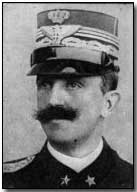Battles - The First Battle of the Isonzo, 1915
 In many ways the Battles of the Isonzo mirrored those on the Western Front, albeit on
a smaller scale. As with
the ongoing battle raging in France and Flanders the lines across the Isonzo were
defined by the onset of trench warfare. For a
single-article background to the Isonzo battles click
here.
In many ways the Battles of the Isonzo mirrored those on the Western Front, albeit on
a smaller scale. As with
the ongoing battle raging in France and Flanders the lines across the Isonzo were
defined by the onset of trench warfare. For a
single-article background to the Isonzo battles click
here.
Italian Policy of Aggressive Warfare
It was certainly never Italian Chief of Staff Luigi Cadorna's intention that the war along the Italian Front should be anything but mobile. For far longer than his contemporaries on the Western Front he persisted in wholly aggressive infantry tactics in determining the strategy for Italian attacks.
Time and again he was determined to break the trench stalemate - and each time circumstances conspired to defeat his objectives.
Whereas Cadorna was desperate to satisfy his Allies (and government) by securing sweeping territorial gains from the Austro-Hungarians, his enemy was perfectly content to maintain a defensive posture. In short, the Austro-Hungarian army (under Eugen and Boroevic) prepared solely for a defensive war - and possession of the mountains along the Isonzo greatly assisted them in their resolve.
Trench Warfare along the Isonzo
But how did trench warfare along the Isonzo come to pass? While hostilities along the Italian Front began officially in late May 1915 with Italy's formal entry into the war on the side of the Allies, preparations for battle had gone on for rather longer.
Cadorna intended to spring surprise attacks across the Isonzo as soon as war began; and his Austro-Hungarian foe, suspecting something of the kind, fortified the mountain passes against likely attack. In the preparation of trenches and defensive lines the Austro-Hungarians had a year's head start, having been in a state of war since late-July 1914.
Countdown to the Battles of the Isonzo
As soon as war was announced Cadorna initiated his surprise offensive, called "the First Jump" (Primo Sbalzo). Launched in distinct areas at points along the Italian Front (and not just along the Isonzo river) the series of attacks were designed to boost the Italian army's position from the first.
Thus, in the north-east the Italians advanced across the Italian-Austrian border to the banks of the Isonzo. Italian General Frugoni rapidly captured Caporetto - later the scene of a spectacular combined German-Austro-Hungarian assault.
Somewhat further south Duke Aosta attempted to advance on Gorizia but was repulsed by prepared Austro-Hungarian forces massed around the city and surrounding mountains.
In the south itself the Italians were unable to make much progress on account of seasonal flooding around Monfalcone (which ought to have been foreseen by Cadorna). Similarly, Italian attacks upon the Tolmino bridgehead, at Mte Krn, failed owing to a lack of planning and sufficient artillery support.
Notwithstanding this Cadorna ordered a concerted attempt to create an Italian bridgehead between Gorizia and Tolmino in an unsuccessful attack which ran from 11-17 June 1915. This was to be the final attack ahead of the First Battle of the Isonzo which began less than a week later on 23 June, the first of four Italian Isonzo assaults throughout the remainder of 1915.
The First Battle of the Isonzo: 23 June-7 July 1915
In numerical terms the Italians enjoyed a marked advantage over their Austro-Hungarian opponents. General Boroevic was able to muster a force of around 100,000 for the Austro-Hungarians while Frugoni and the Duke of Aosta for the Italians had twice that number at their disposal, added to which they possessed around 200 guns.
Despite their seemingly decisive superiority in numbers the Italians - after a one week artillery bombardment of Austrian positions - battered against the Austro-Hungarian lines in vain in their attempt to cross the river and scale the mountains beyond.
Cadorna was duplicating the early mistakes of commanders on the Western Front. He chose to launch massed infantry assaults without first assembling sufficient artillery protection. Further, he had diluted the potency of his attack by launching tactically unnecessary subsidiary attacks in the Trentino and in the central Isonzo near Gorizia.
Two additional divisions of Austro-Hungarian infantry were rapidly despatched to Boroevic's aid and the Austrian commander successfully prevented any Italian crossing of the Isonzo before Cadorna called off his attack after two weeks on 7 July.
The Italians had however made a number of minor gains: Mount Krn was partly occupied and the heights around Plezzo were taken, as was Mount Colowrat (opposite Tolmino).
The pause was brief however; the Second Battle of the Isonzo was launched just eleven days later, on 18 July 1915.
Click here to view a map charting the progress of the first eleven battles of the Isonzo.
Photograph courtesy of Photos of the Great War website
A "dope can" was a metal syringe containing petrol for priming an aircraft engine.
- Did you know?
